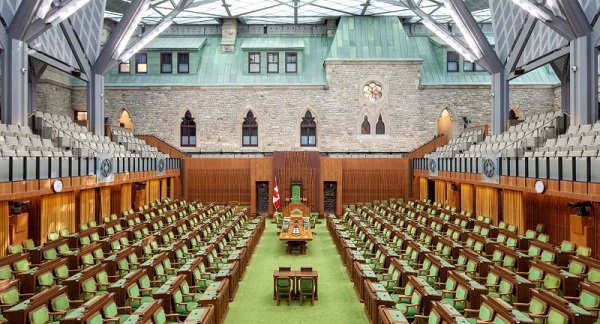Business
Todayville At The Home Show With Canadian Closet
Business
Carney government’s throne speech—different delivery, same old approach to policy

From the Fraser Institute
By Jake Fuss and Grady Munro
For the first time in nearly 70 years, the speech from the throne—which marks the opening of a new Parliament and lays out the government’s policy priorities for the coming term—was delivered directly by Canada’s sovereign, King Charles III, as opposed to the governor general (his representative in Canada). A key theme throughout the speech was the idea of change, and that the Carney government has the opportunity to transform the Canadian economy.
But while Canada certainly needs change, peeling back the rhetoric reveals the government plans to utilize much of the same strategies as its predecessor when addressing the country’s problems. Consider the following three examples.
A New Fiscal Approach
Throughout the election, and again during the throne speech, the Carney government promised a new fiscal principle that will guide all of its actions—“spend less to invest more.” This “new fiscal discipline” is intended to depart from the fiscal approach of the previous government—which Prime Minister Mark Carney has said spent “too much.” To “spend less,” the government plans to split spending into two separate budgets—an operating and capital budget—and slow growth in operating spending to balance the operating budget over the next three years.
The problem is the government’s fiscal math simply doesn’t add up. In the speech, the government commits to major new investments in national defence and law enforcement, and personal income tax cuts—all of which put pressure on the budget. The government rightly identifies the need to cut spending elsewhere to offset this pressure, but essentially hamstrings efforts to rein in spending by taking approximately three-quarters of the budget—including (but not limited to) all transfers to provinces, territories and individuals, and major programs such as national dental care, pharmacare and daycare—off the table.
What is the result of the Carney government’s new fiscal approach? The government will spend more in total, run larger deficits and take on more debt over the next four years than was previously planned by the Trudeau government. Constantly hitting the gas on spending and debt is the same strategy that Carney’s predecessor employed time and time again.
Building the Strongest Economy in the G7
According to the throne speech, the government’s “core mission” is to “build the strongest economy in the G7.” Part of the government’s plan to do this is by removing internal trade barriers—something that has been long overdue—but there’s only so much the federal government can do, as much of the work must be done by the provinces. Missing from the speech was a comprehensive plan to reform and reduce taxes to promote economic growth, along with a clear commitment to dismantle the costly regulatory regime of the Trudeau government.
Canada’s tax system represents a significant drag on the Canadian economy, and while the Carney government plans to lower the bottom federal personal income tax (PIT) rate from 15 per cent to 14 per cent, this change will do little to increase economic growth because it will not meaningfully improve the economic incentives to work, save and invest, nor will it make Canada much better at attracting and retaining professionals, business owners and entrepreneurs. More ambitious and broad-based reforms and tax cuts are needed to make a meaningful impact on growth.
Similarly, it’s unclear whether the Carney government is willing to meaningfully depart from the regulatory regime of the Trudeau government. A number of studies have highlighted how overburdensome regulations implemented under the previous government (including Bill C-69 and the federal emissions cap) act as a major deterrent for the investments and projects needed to grow the economy.
However, despite the Carney government’s commitments to “catalyze” investments and projects while making Canada an “energy superpower,” the government has sent mixed signals regarding its willingness to significantly depart from the previous government’s approach to regulation and the energy sector.
Expanding Role of Federal Government
During the last decade under the Trudeau government, Canada experienced one of the largest increases in the size of government of any advanced country, in large part due to the previous government’s tendency to expand the federal government’s role in the economy (national dental care, pharmacare, daycare, etc.). Unfortunately, the throne speech suggests the Carney government will repeat these mistakes and continue to expand the federal government’s role in the economy.
For example, the government plans to speed up the time it takes to approve major projects within Canada to incentivize new investments and grow the economy. However, instead of eliminating the costly and burdensome regulations that make it hard to build projects in Canada, the Carney government plans to create a new government entity—the Major Federal Project Office—to reduce approval times. In other words, the government will create more bureaucracy and regulation to try and solve a problem created by too much regulation.
Similarly, in its efforts to spur new homebuilding, the Carney government will create another new federal entity called Build Canada Homes, which will “get the government back in the business of building” by acting as a developer to build affordable housing while also providing financing to other affordable homebuilders. However, by increasing the federal government’s role in the economy, and continuing to expand bureaucratic influence, the government is unlikely to “catalyze” significant new homebuilding but it will likely expose taxpayers to significant risks.
Due to the presence of King Charles III, the delivery of this year’s speech from the throne differed significantly from years past. However, in substance, the Carney government promises much of the same.
Alberta
Moving to single 8% provincial personal income tax rate would help restore the Alberta Advantage

From the Fraser Institute
Moving to a single eight per cent personal income tax rate for all working Albertans would dramatically improve the province’s competitiveness among
energy-producing jurisdictions, according to a new study published by the Fraser Institute, an independent, non-partisan Canadian public policy think-tank.
“It’s crucial to restore Alberta’s historic tax advantage and understanding how changes to personal income tax rates affect provincial revenues is critical for informed policy decisions,” said Ergete Ferede, Fraser Institute senior fellow and author of Revenue Effects of Tax Rate Changes in Alberta.
The report examines two potential tax reform scenarios and their impact on provincial revenue: an immediate adoption of an eight per cent single tax rate starting in 2025; and a gradual move to that same rate over three years.
An immediate switch to an eight per cent single personal income tax (PIT) rate would decrease PIT revenue by about $6.1 billion (a 35.6 per cent reduction) in the first year.
A gradual transition over three years would start with a smaller loss of $264 million (a 1.5 per cent reduction) in 2025 increasing to $6.9 billion (37.0 per cent reduction) by 2027. However, these estimates may overstate provincial revenue losses as they do not account for the potential positive economic effect of personal income tax reductions on other revenue sources.
Alberta’s current combined federal and provincial personal income tax rate stands at 48 per cent—ranking 10th highest out of 61 jurisdictions in North America—and is significantly higher than other energy-producing regions such as Texas or Wyoming. Implementing a single 8 per cent tax rate would help re-establish Alberta as a low-tax jurisdiction, lowering its rank to the 16th lowest among the 61.
“The potential to strengthen Alberta’s economic position through tax cuts must be considered along with the revenue implications for the government,” Ferede said.
-

 Fraser Institute22 hours ago
Fraser Institute22 hours agoFederal government’s ‘affordable housing’ strategy doomed without strong income growth
-

 Addictions2 days ago
Addictions2 days agoMan jailed for trafficking diverted safer supply drugs, sparking fresh debate over B.C. drug policies
-

 Alberta2 days ago
Alberta2 days agoHow Trump and Alberta might just save Canada
-

 Business2 days ago
Business2 days agoCanada is falling apart and our leaders don’t seem to care
-

 Business2 days ago
Business2 days agoTrump furious over Putin’s Kyiv strikes: Sanctions “absolutely” possible
-

 Business2 days ago
Business2 days agoOntario government will spend more—for less housing
-

 National2 days ago
National2 days agoCourt rules against suicide prevention group, undermining freedom of religion
-

 2025 Federal Election2 days ago
2025 Federal Election2 days agoJudicial recounts give Conservatives 2 more seats, keeping Liberals short of majority







